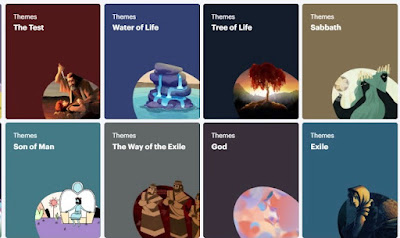Big Idea: Follow words and key ideas that become links throughout the Bible to track Biblical themes.
Links throughout Scripture
A popular Study Bible called the Thompson Chain Reference Bible has been around for over 100 years. It is a heavy Bible! Dr. Frank Charles Thompson, a pastor, wanted to make a tool for both pastors and ordinary Christians to help them trace key words that permeate the Bible. He said they were like chain links. It is still a sought out Bible for serious study.BibleProject Videos on Themes
More recently, an organization called the BibleProject began developing informative videos to help people understand the Bible from its original writings to help our lives today. These free tools use multiple electronic formats such as videos, podcasts and online classes. They focus each year on an aspect that helps Bible understanding. They recently put it all together in an app. All the videos, podcasts, blogs and classes remain online. The app organizes them and takes it to a whole new level! (Download at Google Play and the App Store). They organize their tools to correspond together to help you study the Bible better. Their Bible reading program includes information you can click on and apply as you read.Using the Helpful Skills Page in the BibleProject App
It is helpful to go to bottom of the opening page by opening the heading “Skills.”
The skills section has three headings: Pattern, Style and Structure
Pattern: Lists themes in the Bible with videos and podcasts that correspond
Style: Lists literary styles the BibleProject covers, with videos and podcasts listed
Structure: The section guides you through practice in a couple specific chapters of the Bible to look at the patterns and links.
What Thompson Chain Reference Bible calls “chains” is similar to what is called "links" by the BibleProject. The Bible has a lot of specific words and ideas that can be traced, which are key themes throughout the Bible. Most of these start in Genesis from the very beginning and go all the way to Revelation.
One word example is “Blessing.” This word is often connected with other words, such as abundant, fruitful, life, and rest. The way BibleProject puts it, when you see this word later in Scripture, it activates the theme. Look for how it links to what you have already learned about it.
Check out this BibleProject video on Links for more insight.
This is fourth and last in a series, The Bible in Sync - September 2022
Next Post: The Holy Spirit Starting in Genesis
______________________
Reflect:
Name a theme you are familiar with in the Bible. How do you see it play out in other parts of the Bible?
Here is an example for you to try.
For an all powerful God, He is gentle with us, and we should reflect His gentleness.
.jpg)








.jpg)
